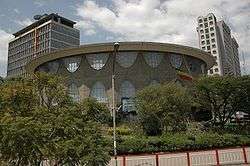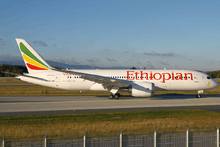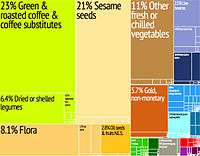Economy of Ethiopia
 | |
| Currency | Birr (ETB) |
|---|---|
| 8 – 7 July | |
Trade organisations | AU, WTO (observer) |
| Statistics | |
| GDP |
$132 Billion (2014 est.)[1] $51 Billion (2014 est.)[2] |
GDP growth | 7% [3] |
GDP per capita |
$1,455 PPP (2014 est.)[1] $570 Nominal (2014 est.)[2] |
GDP by sector | agriculture (46.6%), industry (14.5%), services (38.9%) (2011) |
| 8.0 % [4] | |
Population below poverty line | 28.7% (2011) |
Labour force | 37.9 million 2007 Estimate |
Labour force by occupation |
|
| Unemployment | 24.9% [3] |
Main industries | food processing, beverages, textiles, leather, chemicals, metals processing, cement, military equipment |
| 125th (2014)[5] | |
| External | |
| Exports | $3.163 billion [3] |
Export goods | coffee, qat, gold, leather products, live animals, oilseeds |
Main export partners |
|
| Imports | $10.6 billion [3] |
Import goods | food and live animals, petroleum and petroleum products, chemicals, machinery, motor vehicles, cereals, textiles |
Main import partners |
|
| Public finances | |
| 42.3% of GDP | |
| Revenues | $4.645 billion (2011) |
| Expenses | $5.25 billion, capital expenditures of $788 million (2005) |
| Economic aid | $308 million (recipient) (2001) |
The economy of Ethiopia is largely based on agriculture, which accounts for 46.6% of the gross domestic product (GDP) and 85% of total employment.
Ethiopia has one of the fastest-growing economies in the world and is Africa’s second most populous country.[8] Many properties owned by the government during the previous regime have now been privatized and are in the process of privatization.[9] However, certain sectors such as telecommunications, financial and insurance services, air and land transportation services, and retail, are considered as strategic sectors and are expected to remain under state control for the foreseeable future. Almost 50% of Ethiopia's population is under the age of 18, and even though education enrollment at primary and tertiary level has increased significantly, job creation has not caught up with the increased output from educational institutes. The country must create hundreds of thousands of jobs every year just to keep up with population growth.[10]
The Ethiopian constitution defines the right to own land as belonging only to "the state and the people", but citizens may only lease land (up to 99 years), and are unable to mortgage, sell, or own it.[11] Various groups and political parties have sought for full privatization of land, while other opposition parties are against privatization and favor communal ownership.
The current government has embarked on a program of economic reform, including privatization of state enterprises and rationalization of government regulation. While the process is still ongoing, the reforms have begun to attract much-needed foreign investment. Despite recent improvements, Ethiopia remains one of the poorest nations in the world.[12]
Sectors
Agriculture
The economy of Ethiopia is based on agriculture, which accounts for 46.3% of gross domestic product (GDP), 60% of exports, and 80% of total employment.
Ethiopia's agriculture is plagued by periodic drought, soil degradation caused by overgrazing, deforestation, high population density, high levels of taxation and poor infrastructure (making it difficult and expensive to get goods to market). Yet agriculture is the country's most promising resource. A potential exists for self-sufficiency in grains and for export development in livestock, grains, vegetables, and fruits. As many as 4.6 million people need food assistance annually.
Agriculture accounts for almost 41 percent of GDP, 80 percent of exports, and 80 percent of the labour force. Many other economic activities depend on agriculture, including marketing, processing, and export of agricultural products. Production is overwhelmingly of a subsistence nature, and a large part of commodity exports are provided by the small agricultural cash-crop sector. Principal crops include coffee, pulses (e.g., beans), oilseeds, cereals, potatoes, sugarcane, and vegetables. Exports are almost entirely agricultural commodities, with coffee as the largest foreign exchange earner, and its flower industry becoming a new source of revenue: for 2005/2006 (the latest year available) Ethiopia's coffee exports represented 0.9% of the world exports, and oilseeds and flowers each representing 0.5%.[13] Ethiopia is Africa's second biggest maize producer.[14] In 2000, Ethiopia's livestock contributed to 19% of total GDP.[15]
As of 2008, some countries that import most of their food, such as Saudi Arabia, had begun planning the development of large tracts of arable land in developing countries such as Ethiopia.[16] This has raised fears of food being exported to more prosperous countries while the local population faces its own shortage.[16]
Forestry
Forest products are mainly logs used in construction. Paper industry does not exist, and the silvicutural properties are used in construction and manufacturing, and as energy sources.
Poverty
The level of poverty in Ethiopia is extremely high. Ethiopia has the second largest population of all African countries and has only once, for a brief period of time, been occupied. One of Africa’s oldest independent countries, Ethiopia has a rich culture and long history. However, it is currently considered one of Africa’s poorest countries despite a rapid population boom in recent decades.
Fishing
Ethiopia's fisheries are entirely freshwater, as it has no marine coastline, and are a small part of the economy.
Minerals and mining
The mining sector is small in Ethiopia. The country has deposits of coal, opal, gemstones, kaolin, iron ore, soda ash, and tantalum, but only gold is mined in significant quantities. In 2001 gold production amounted to some 3.4 tons.[17] Salt extraction from salt beds in the Afar Depression, as well as from salt springs in Dire and Afder districts in the south, is only of internal importance and only a negligible amount is exported.
On 30 August 2012 it was announced that British firm Nyota Minerals was about to become the first foreign company to receive a mining licence to extract gold from an estimated resource of 52 tonnes in western Ethiopia.[18]
Energy
Waterpower and forests are Ethiopia's main energy sources. The country derives about 90 percent of its electricity needs from hydropower, which means that electricity generation, as with agriculture, is dependent on abundant rainfall. Present installed capacity is rated at about 2000 megawatts, with planned expansion to 10,000 megawatts. In general, Ethiopians rely on forests for nearly all of their energy and construction needs; the result has been deforestation of much of the highlands during the last three decades.[17]
Less than one-half of Ethiopia’s towns and cities are connected to the national grid. Petroleum requirements are met via imports of refined products, although some oil is being hauled overland from Sudan. Oil exploration in Ethiopia has been underway for decades, ever since Emperor Haile Selassie granted a 50-year concession to SOCONY-Vacuum in September 1945.[19]
Recent oil and gas discoveries across East Africa have seen the region emerge as a new player in the global oil and gas industry. As exciting as the huge gas fields of East Africa are, however, the strong decline in oil prices and expectations for an L-shaped recovery with low prices over the coming years are increasingly challenging the economic viability of the industry in this region.[20][21] The reserves are estimated at 4 trillion cubic feet (110×109 m3), while exploration for gas and oil is underway in the Gambela Region bordering Sudan.[17]
The discoveries were expected to drive billions of dollars in annual investment to the region over the next decade.[22] According to BMI estimates, the finds in the last few years are more than that of any other region in the world, and the discoveries are expected to continue for the next few years. However, falling global oil prices are threatening the commercial viability of many of these gas prospects.[23]
Manufacturing
This sector constitutes about 4 percent of the overall economy, although it has shown some growth and diversification in recent years. Much of it is concentrated in Addis Ababa. Food and beverages constitute some 40 percent of the sector, but textiles and leather are also important, the latter especially for the export market. A program to privatize state-owned enterprises has been underway since the late 1990s.[17]
Transport

Prior to the outbreak of the 1998–2000 Eritrean–Ethiopian War, landlocked Ethiopia mainly relied on the seaports of Asseb and Massawa in Eritrea for international trade. As of 2005, Ethiopia uses the ports of Djibouti, connected to Addis Ababa by the Addis Ababa – Djibouti Railway, and to a lesser extent Port Sudan in Sudan. In May 2005, the Ethiopian government began negotiations to use the port of Berbera in Somaliland. Of the 23,812 kilometres of Ethiopia's all-weather roads, 15% are asphalt. Mountainous terrain and the lack of good roads and sufficient vehicles make land transportation difficult. However, the government-owned airline, Ethiopian Airlines, is Africa's largest airline.[24] It serves 41 domestic airfields and has 65 international destinations.
Telecommunications
Telecommunications are provided by a state-owned monopoly, Ethio Telecom, formerly the Ethiopian Telecommunications Corporation.
Tourism
Aside from wholesale and retail trade, transportation, and communications, the services sector consists almost entirely of tourism. Developed in the 1960s, tourism declined greatly during the later 1970s and the 1980s under the military government. Recovery began in the 1990s, but growth has been constrained by the lack of suitable hotels and other infrastructure, despite a boom in construction of small and medium-sized hotels and restaurants, and by the impact of drought, the 1998–2000 war with Eritrea, and the specter of terrorism. In 2002 more than 156,000 tourists entered the country, many of them Ethiopians visiting from abroad, spending more than US$77 million.[17] In 2008, the number of tourists entering the country had increased to 330,000.[25]
Macro-economic trend

The following table displays the trend of Ethiopia's gross domestic product at market prices, according to estimates by the International Monetary Fund with figures in millions of Ethiopian Birr.[26]
| Year | Gross Domestic Product | GDP (USD) | US Dollar |
|---|---|---|---|
| Birr (millions) | per capita | Exchange | |
| 1980 | 14,665 | 190 | 2.06 Birr |
| 1990 | 25,011 | 257 | 2.06 Birr |
| 1995 | 47,560 | 148 | 5.88 Birr |
| 2000 | 64,398 | 124 | 8.15 Birr |
| 2005 | 106,473 | 169 | 8.65 Birr |
| 2006 | 131,672 | 202 | 8.39 Birr |
| 2007 | 171,834 | 253 | 8.93 Birr |
| 2008 | 245,973 | 333 | 9.67 Birr |
| 2009 | 353,455 (est) | 418 (est) | 12.39 Birr |
| 2010 | 403,100 (est) | 398 (est) | 13.33 Birr |
The current GDP (USD) per capita of Ethiopia shrank by 43% in the 1990s.[27]
External trade

Until 2013, the major agricultural export crop was coffee, providing about 26.4% of Ethiopia's foreign exchange earnings. In the beginning of 2014, oilseeds exports have been more important.[28] Coffee is critical to the Ethiopian economy. More than 15 million people (25% of the population) derive their livelihood from the coffee sector.[29]
Other exports include live animals, leather and leather products, chemicals, gold, pulses, oilseeds, flowers, fruits and vegetables and khat (or qat), a leafy shrub which has psychotropic qualities when chewed.
Cross-border trade by pastoralists is often informal and beyond state control and regulation. In East Africa, over 95% of cross-border trade is through unofficial channels and the unofficial trade of live cattle, camels, sheep and goats from Ethiopia sold to Somalia, Kenya and Djibouti generates an estimated total value of between US$250 and US$300 million annually (100 times more than the official figure).[30] This trade helps lower food prices, increase food security, relieve border tensions and promote regional integration.[30] However, there are also risks as the unregulated and undocumented nature of this trade runs risks, such as allowing disease to spread more easily across national borders. Furthermore, the government of Ethiopia is purportedly unhappy with lost tax revenue and foreign exchange revenues.[30] Recent initiatives have sought to document and regulate this trade.[30]
Dependent on a few vulnerable crops for its foreign exchange earnings and reliant on imported oil, Ethiopia lacks sufficient foreign exchange. The financially conservative government has taken measures to solve this problem, including stringent import controls and sharply reduced subsidies on retail gasoline prices. Nevertheless, the largely subsistence economy is incapable of supporting high military expenditures, drought relief, an ambitious development plan, and indispensable imports such as oil; it therefore depends on foreign assistance.
In December 1999, Ethiopia signed a $1.4 billion joint venture deal with the Malaysian oil company, Petronas, to develop a huge natural gas field in the Somali Region. By the year 2010, however, implementation failed to progress and Petronas sold its share to another oil company.[31]
See also
References
- 1 2 "Ethiopia". International Monetary Fund. Retrieved 1 October 2014.
- 1 2 "Ethiopia". International Monetary Fund. Retrieved 1 October 2014.
- 1 2 3 4 "Ethiopia. CIA The World Fact Book". CIA Factbook. Retrieved 20 February 2013.
- ↑ "Ethiopian inflation dropped in December to 12.9 percent". Walta Information. 11 January 2013. Retrieved 20 February 2013.
- ↑ "Economy rankings". Doingbusiness.org. Retrieved 1 October 2014.
- ↑ "Export Partners of Ethiopia". CIA World Factbook. 2013. Retrieved 2015-05-11.
- ↑ "Import Partners of Ethiopia". CIA World Factbook. 2013. Retrieved 2015-05-11.
- ↑ "Private Sector Boosts Ethiopia's Growth". IFC. Retrieved 27 December 2012.
- ↑ "Ethiopia sells off seven state firms, to offer more". Reuters. 19 March 2012. Retrieved 27 December 2012.
- ↑ "A brittle Western ally in the Horn of Africa". The Economist. 11 November 2007. Retrieved 23 November 2007.
- ↑ "Ethiopian Constitution". Retrieved 11 June 2015.
- ↑ "The 10 Poorest Countries Of The World; Ethiopia 10th place". Retrieved 2016-09-28.
- ↑ "The Federal Democratic Republic of Ethiopia: Selected Issues Series", International Monetary Fund Country Report No. 08/259, pp. 35f (Retrieved 4 February 2009)
- ↑ "Get the gangsters out of the food chain". The Economist. 7 June 2007.
- ↑ Food and Agriculture Organization (May 2004). "Livestock Sector Brief: Ethiopia" (PDF). FAO Country Profiles. FAO. p. 1. Retrieved 7 November 2011.
- 1 2 Blas, Javier; Andrew England (20 August 2008). "Arable Land, the new gold rush". Financial Times. London. Retrieved 6 November 2009.
Meles Zenawi, the prime minister of Ethiopia, is also enthusiastic. After welcoming a Saudi agriculture delegation a fortnight ago, he said: 'We told them [the Saudis] that we would be very eager to provide hundreds of thousands of hectares of agricultural land for investment.'
- 1 2 3 4 5 Ethiopia country profile. Library of Congress Federal Research Division (April 2005). This article incorporates text from this source, which is in the public domain.
- ↑ Matthew Newsome, "Gold mining promises big boost for Ethiopia's development", The Guardian (30 August 2012)
- ↑ "Sinco Places a Bet", Time, 17 September 1945 (Retrieved 14 May 2009)
- ↑ "Is East Africa's gas asset boom about to go bust?". Mineweb. Retrieved 2016-02-18.
- ↑ "Africa's exports by region | Bright Africa". www.riscura.com. Retrieved 2016-02-18.
- ↑ "Oil And Gas Discoveries Near Africa's East Coast To Soon Drive Billions In Investments: PWC". International Business Times. Retrieved 2016-02-18.
- ↑ Krauss, Clifford (2016-01-06). "Oil Prices: What's Behind the Drop? Simple Economics". The New York Times. ISSN 0362-4331. Retrieved 2016-02-18.
- ↑ "Ethiopian Airlines 2015 outlook: more rapid expansion as it becomes Africa's largest airline". CAPA Centre for Aviation. 13 January 2015. Archived 13 January 2015 at the Wayback Machine.
- ↑ "UNdata country profile: Ethiopia". Retrieved 15 July 2011.
- ↑ "Edit/Review Countries". Retrieved 11 June 2015.
- ↑ "What We Do". Retrieved 11 June 2015.
- ↑ "Oilseed overtakes coffee as Ethiopia’s top export earner" Ethiosports, 2014. (Retrieved 1 July 2014)
- ↑ "Ethiopian coffee: The best in the world?" African Business, 2001. (Retrieved 24 January 2007)
- 1 2 3 4 Pavanello, Sara 2010. Working across borders - Harnessing the potential of cross-border activities to improve livelihood security in the Horn of Africa drylands. London: Overseas Development Institute
- ↑ "Petronas sells Ethiopian assets to SouthWest" Upstream Online news, 6 October 2010. (Retrieved 10 December 2010)
 This article incorporates public domain material from the CIA World Factbook website https://www.cia.gov/library/publications/the-world-factbook/index.html.
This article incorporates public domain material from the CIA World Factbook website https://www.cia.gov/library/publications/the-world-factbook/index.html.
External links
- Economy of Ethiopia at DMOZ
- Addis Fortune, an online economics and finance journal
- Ethiopia in Talks Over Use of Somali Port - The East African Standard (Nairobi), 27 May 2005
- Ethiopia latest trade data on ITC Trade Map
- Ethiopia has a marginal tax rate of 89% on farmers' profits
- National Bank of Ethiopia: History of banking in Ethiopia
- Pieter Serneels, "The Nature of Unemployment in Urban Ethiopia", WPS/2004-01, Centre for the Study of African Economies website
- World Bank Ethiopia Summary Trade Statistics